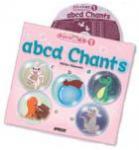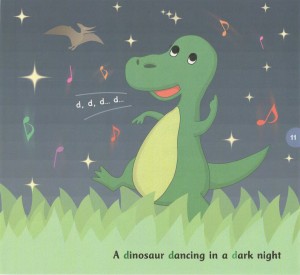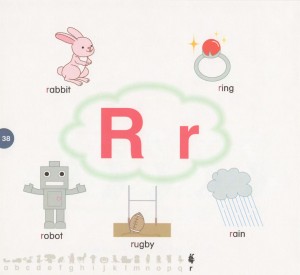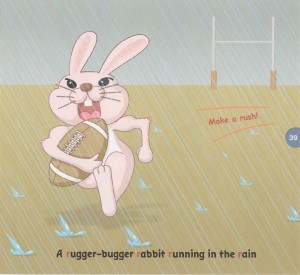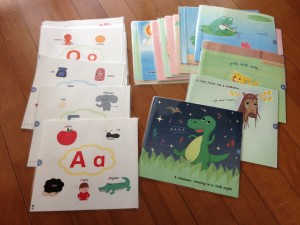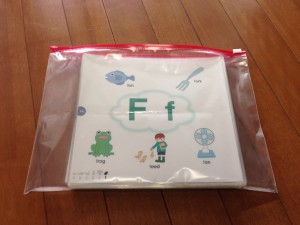

abcd Chants
I’m going to start off by saying that I absolutely love “abcd Chants”. It may be one of my favorite books in the Picture Books by Chants series. If it is not my favorite, it is definitely the book that I use the most.
I can still remember the day that I first got a copy of it. We had just moved back to Japan after living in the States for 2 years. I was setting up my room for my English classes. My daughter Hana, who was 3 1/2 at the time, saw “abcd Chants” and asked me to read it to her. I told her I didn’t have time right then, but would read it for her later. Obviously, she didn’t like this answer. So I put the audio CD in my computer for her and told her to follow along with the CD. I continued setting up my room. The next time I looked over at her, she was already on ‘W’ and completely absorbed in the book. This experience is partially responsible for leading me to use the picture books audio in my classes more.
Anyway, fast forward a few months and I introduced the book to one of my classes. It was successful until about ‘F’ or ‘G’, when the kids became restless and lost interest. What I realized then is that it was just too long to use straight through from A to Z for most Japanese kids. It is hard to focus on new English for that long at one time.
Since then, I have very heavily integrated “abcd Chants” into my phonics program. (I’ll write more about my current phonics program later.) I love that the book introduces more words (five words) for each letter and my students love the drawings and short chants for each letter.
They especially love “A dinosaur dancing in a dark night”.
You can hear the audio for it here.
And since a few of them play rugby, “A rugger-bugger rabbit running in the rain” is also highly requested.
We usually focus on between 4-5 letters at a time. I play the audio and look at the pages for whichever letters we are focusing on. Originally, I was using the book, but kept thinking that what I really wanted were cards that had the letter on one side and the chant on the other. Finally, I bought 2 more copies of “abcd Chants”. I carefully cut the binding off using a cutter and a ruler. Then, because the letter and picture pages are on a spread – not reverse pages, I used a bit of nori tape to tape the pages together. (Only put a bit on the end you will feed through the laminator first, otherwise you’ll end up with wrinkles.) Then I slid the pages into laminating film and laminated them. Now, instead of flipping through the book to the page I want to use that day, I can hold up the card for that letter. It also allows me a bit more control because, using the book, sometimes kids get distracted by the picture page and don’t focus on the words page.
There are also games that I can play with the cards…
Put the cards out letter side up and say the chant. The students have to find the right card.
I also do a kind of rock-scissors-paper game (I’m sure there’s a Japanese word for it…). I put out the letter cards in a line. Two students start at opposite ends of the line. The students have to say the sound and word for the letter, then go to the next card and do the same. When they meet in the middle, they have to do rock-scissors-paper. The loser (or the next person on the loser’s team) starts over and the winner continues. The game ends when one team gets to the other end of the line. I usually play twice, having the teams switch ends so they get practice with all the letters. I have used cards with just letters for this game in the past, but using my “abcd Chants” cards would be better for students who are having a hard time remembering what sound the letter makes.
I’ve thought about buying another book or two to cut up and make a classroom alphabet border with, but I don’t have much wall space in my current classroom. An idea for the future…
You can hear audio for some of the other letters on the Audio Samples page.
Where? When? How?
I love using games in class! There are a couple of really great points about using games.
- Students have fun while practicing the target language.
- Games are a great chance for teaching and using “other” English.
This “other” English is stuff like negotiating whose turn, understanding the rules of the game, and checking that they’ve understood the rules while playing the game. In the past, I used to use more Japanese in class than I do now. I would sometimes explain the rules in Japanese so that we could spend more time practicing the target language. But then I went to one of Matthew de Wilde’s presentations and it made me think about the importance of this “other” language. So, now I use less Japanese in class.
This game is one that I developed with Learning World 2, Unit 6, Lesson 2. I used the Activity Sheets for this lesson to introduce the language and had the students sort the cards into the correct categories of “where”, “when”, and “how”. This was great, but I wanted to make a game to practice more. I often use small playing cards to play games. I have lots of games for pairs and a good one for 4-card sets, but this time I had 3 categories… I finally came upon the perfect idea: Clue!
The original Clue game is a murder mystery game. Someone has murdered the owner of the mansion. The board has nine rooms, there are characters and weapons. The winner has to correctly guess who did it, with what, and where.
The Activity Sheets had 9 places. Perfect! So I made a new game. The basic rules of the game are that you take one card from each category and hide them in an envelope. That is the answer. You deal out the remaining cards. Any card that you have in your hand is not in the envelope, so you can mark it off on your score sheet as not being the answer. During the game play, students move from room to room. Each time, they enter a room, they can make a guess. The guess includes one item from each category. Students have to guess by saying something like:
“Let’s go to the park on Sunday by bike.”
If the first student to their left has one (or more) of the cards, they have to show it just to the student making the guess. And if they have more than one, they can pick the one to show. If the first student does not have any of the cards guessed, then it moves on to the next student. As you see cards from other students, you can mark them off on your list. When only one item is left you know that that one item is the answer for that category. Once you know all of the items, you can make a final statement. If you are right, you win. If not, the rest of the students continue playing.
We didn’t completely finish the first game in the 50-minute class. It took them about half of that time to really get the rules. Once they got the rules, it was like a light bulb went off. The next class, we spent the entire 50 minutes playing the game. With 4 people playing that is about how long it took. You might think, “50 minutes just playing one game?!?” But the students loved it and were having fun. They were using lots of English! And not just the target language. There were things being said, like:
“Whose turn is it?”
“Do you have one of those cards?” “Do you have one?” “I’m sure you have it!”
“No, I don’t have one.” “Oops. I do have one.”
“Hey! You have that card!” (At the end of the game, after a student had made a mistake during the game.)
Here is everything you need to make the game yourself, including detailed instructions for making and playing the game!
Self-Introduction
I haven’t been teaching for as long as many of you have been teaching, but I have been lucky to have the opportunity to meet many wonderful teachers, authors and editors and learn about their ideas on how to use the materials and activities that can be done in class.
In the past, I worked for AEON in Izumo teaching both children and adults. I have to confess that a lot of what I did during those early years was not as successful as it could have been, due to my own inexperience and lack of exposure to other ideas. I did try my best to meet my students’ needs, but after three years was a bit burned out. Then I moved to Tokyo and began working for Macmillan, where I stayed for five years. One of the best things for me about this time period was all of the wonderful educators I was able to learn from. It gave me motivation and made me want to start teaching again.
After leaving Macmillan, I met APRICOT. Meeting APRICOT led to one of the bigger changes in my teaching of children. I have always been flexible in how I use textbooks, but APRICOT materials really opened up this flexibility for me, and helped me to realize how much more creative classes could be. APRICOT has also given me the courage to challenge my students in ways that I might not have done otherwise.
Currently, I teach English at my own slowly growing school, work with APRICOT, and teach a couple of university classes. I am constantly evaluating what I do in my classes to try and make them better. I also try to attend as many teaching seminars and events as possible so that I can meet other teachers and exchange ideas. I love to share ideas and nothing pleases me more than to hear that something I did was useful and helped someone else.
If you have questions about anything you find on this blog please send me an email and I would be happy to answer your questions and maybe address it in another blog post.
My email is sam(at)apricot-plaza(dot)co(dot)jp.
Introduction to Sam’s Blog
At JALT National, one of the plenary speakers (I think it was Penny Urr) said something that really struck me. She asked the audience, “Are you a teacher? Or are you a learner?” I thought about this. I am a teacher, but I am constantly learning new things, so I debated and then raised my hand with the learners. Then she went on to talk about what it really means to be a teacher and a learner. I don’t remember what she said about learners, but what she said about teachers seemed to really fit me. She said a teacher was someone who was always trying to share their knowledge and help others. Well, that seems to describe me pretty accurately. I am always trying to learn new things, a better way of doing what I am doing. Then I take whatever I learn and share it with those around me who I think it will benefit.
When it comes to teaching, I am always thinking about my students and what will resonate with them. I also love talking to other teachers about what they are doing in their classes. By talking with other teachers, I get little ideas here and there that improve my classes: ideas about teaching pronunciation, using puppets in class, making lapbooks, using crafts. I usually take this core idea that I pick up and adjust it to fit my students.
Through this blog, I would like to share some of the things I have done (am doing) with my students that have really worked out well. I will also post games and other materials with some of the posts, so that you can try them out with your classes. I hope that you will feel free to use anything you find here and CHANGE IT however you would like to make it fit your students. No two classes are the same, and often what works with one class does not work with another, as I’m sure you know.
If you have questions about anything you find on this blog please send me an email and I would be happy to answer your questions and maybe address it in another blog post.
My email is sam at apricot-plaza dot co dot jp.












